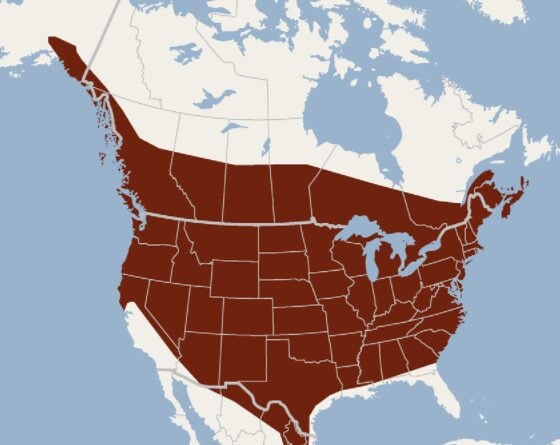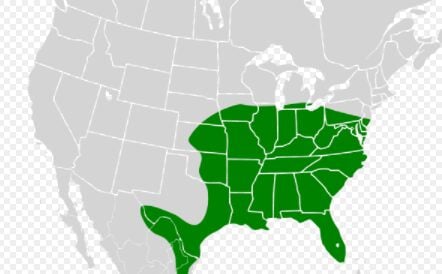9 Types of Bats In Nebraska! (ID GUIDE)
How can anyone in Nebraska think that bats are scary?

Despite what you see in the movies, these fascinating flying mammals wouldn’t hurt a fly! Well, technically, they would hurt a fly, or a mosquito, or a moth. But other than that, bats are harmless. 🙂
It’s hard to believe the diversity and amount of bat species that can be found in Nebraska! But, unfortunately, when you see a bat, it’s typically pretty difficult to determine which kind it is. These nocturnal creatures fly incredibly fast and are only active at night.
9 kinds of bats in Nebraska:
#1. Big Brown Bat
- Eptesicus fuscus

- It is a larger bat with around a 12-inch (30 cm) wingspan.
- Brown fur with black ears, wings, and feet. Wings are hairless.
Big Brown Bats are among the most common bats in Nebraska.
If you look, you’ll find these bats inside caves, tunnels, or other human structures.
Big Brown Bat Range Map
This nocturnal bat primarily eats insects, especially ones that fly at night. However, their preference is to eat beetles.
The Cucumber Beetle is their favorite, which benefits farmers because these insects are terrible pests for agriculture. Many farmers in Nebraska even use bat boxes to attract Big Brown Bats to their property!
Interestingly, many Big Brown Bats have immunity to rabies. Researchers discovered that these rabies antibodies get passed down from generation to generation!

#2. Hoary Bat
- Lasiurus cinereus

- Brown hair with grayish-white tips. Wings and belly are brown and hairless, with a wingspan of approximately 15.5 inches (39 cm).
- Males are almost double the size of females.
You’ll typically find Hoary Bats in Nebraska roosting on trees in woodland forests. They are solitary bats that roost in open foliage. They do form “flocks” when migrating south in late summer, but they don’t hang out with other bats normally.
Hoary Bat Range Map
This species prefers to hunt for prey while flying over wide-open areas or lakes. Hoary Bats hunt alone and enjoy eating moths. They’re known to travel up to 24 miles (39 km) in a single night to gather food!
Though the Hoary Bat is not endangered, it does suffer a loss in numbers because of wind turbines. Hoarys migrate each year back and forth from North America to Central America, and it’s thought that they confuse the wind turbine with a tree as they seek a place to rest.
#3. Silver-haired Bat
- Lasionycteris noctivagans

- Medium-sized with a flathead. The upper part of the tail is covered in thick fur.
- Mostly black all over with white tips on hairs, with a wingspan of approximately 11.5 inches (29 cm).
This species is known to fly more slowly than other bats in Nebraska.
Look for Silver-haired Bats in forests inside tree cavities or bark crevices. They’ve also been known to seek shelter in outbuildings.
Silver-haired Bat Range Map
Silver-haired Bats hunt for soft-bodied insects, such as moths. Interestingly, they also eat a lot of spiders. They accomplish this feat by foraging low to the ground to find food, unlike many other bats.
#4. Little Brown Bat
- Myotis lucifugus

- Glossy brown fur on the body. Wings are hairless and black, with a wingspan of approximately 10 inches (25 cm).
- Despite its name, it has no connection to the Big Brown Bat.
Look for the Little Brown Bat roosting in Nebraska in sheltered places such as human structures, woodpiles, tree hollows, and occasionally caves.
You can even attract Little Brown Bats to your yard! Many people put up bat houses to attract them to their property to control pests like mosquitos or insects that harm crops.
- RELATED: The 7 BEST Bat Houses For Sale! (All price ranges)
Little Brown Bat Range Map

Distribution of all little brown bat subspecies: M. l. lucifugus (red), M. l. pernox (green), M. l. alascensis (blue), M. l. carissima (yellow), M. l. relictus (gray)
Little Brown Bats only have a few natural predators, like owls or raccoons. Unfortunately, most of their mortality is caused by parasites or White-nose syndrome.
White-nose syndrome is a fungal disease that grows around the bats’ mouths, ears, and wings. This illness is spread during hibernation and is responsible for the loss of over one million Little Brown Bats between 2006 and 2011. As of 2018, the Little Brown Bat is an endangered species.
#5. Eastern Red Bat
- Lasiurus borealis

- Medium-sized tree bat with thick, long fur. Ears are short and round. Wings are long, pointed, and have a wingspan of approximately 13 inches (33 cm).
- Males have distinctive rusty red-colored fur, and females have more of a soft shade of red.
- Both have white patches of fur on their shoulder.
Eastern Red Bats like to roost in trees in Nebraska.
These bats are relatively fast flyers with good maneuverability. They are insectivorous, which means they prey primarily on different insects, with their favorite being moths.
Eastern Red Bat Range Map
Unlike most bats that only produce one offspring, Eastern Red Bats have three pups in a litter.
Eastern Red Bats have few predators. However, sometimes hawks, aggressive Blue Jays, and crows attack them. This bat is also killed by flying into cars or wind turbines. Unfortunately, this species has the second-highest mortality rate from wind turbines.

#6. Evening Bat
- Nycticeius humeralis

- Smaller bat with a prominent dog-like jaw.
- Most are dark brown with black muzzle, ears, legs, and wings, but some are lighter brown. Their wingspan is approximately 10.5 inches (27 cm).
Evening Bats have a shorter life span than other bats in Nebraska.
Most only live for four years, but some are lucky enough to make it to six years.
Evening Bat Range Map
But luckily, they have largely avoided the dreaded White-nose syndrome, a terrible disease that has killed millions of bats over the years. They have managed this because they don’t enter or hibernate in caves.
Look for Evening Bats roosting in structures, including tree cavities, under bark, in Spanish moss, and in buildings. They eat various insects, including beetles, moths, winged ants, and flies.
#7. Townsend’s Big-eared Bat
- Corynorhinus townsendii

- Medium-sized bat with extraordinarily long and thin ears. Lumps on each side of the nose.
- Dense fur all over, and colors vary from grayish brown to brown. Their wingspan is approximately 12 inches (30 cm).
It’s pretty easy to see how these bats got their name! Their large ears are essential, as they help them distinguish between ambient noise and sounds of prey or predators.
Townsend’s Big-eared Bat Range Map
During summer, males and females inhabit different roosting sites. Males live alone, while females form colonies where they raise their pups.
This species is known as a “whisper bat” because it echolocates much lower than other bats. This is handy when foraging on moths because moths can hear bats’ echolocation. So, as you can see, being quieter gives Townsend’s Big-eared Bat an advantage.
#8. Western Small-footed Myotis
- Myotis ciliolabrum

- Smaller bat, with yellowish-brown fur and sometimes white underparts.
- The muzzle, chin, and ears are black. Ears are also long. Their wingspan is approximately 9 inches (23 cm).
- Feet are tiny, just as their name suggests.
The Western Small-footed Bat is found in semi-arid habitats in Nebraska.
Though this bat is a slower flyer, it can maneuver well. The Western Small-footed Bat tends to feed close to the water, searching for insects like beetles, moths, and flies.
Western Small-footed Bat Range Map
Western Small-footed Bat females roost in groups, and males roost alone, but both hibernate in winter in solitude.
#9. Fringed Myotis
- Myotis thysanodes

- Smaller bat with long ears and a tiny face. The wingspan is approximately 11 inches (28 cm).
- Light yellowish-brown or dark greenish fur and back and off-white on the underside, brownish-black ears, wings, and legs.
In Nebraska, you’ll find the Fringed Myotis in desert shrublands, sagebrush grasslands, and woodland habitats with pine and oak trees.
Fringed Myotis Range Map
These bats have a diet that consists primarily of beetles.
The Fringed Myotis has a fringe of short, wire-like hairs on the membrane between its hind legs, which is how it got its name. It has been thought that these hairs help it catch insects while flying.
Do you need additional help identifying bats in Nebraska?
If so, this field guide should be able to help you.
Which of these bats have you seen before in Nebraska?
Leave a comment below!
Check out my other guides about animals in Nebraska!
-
Owl Species That Live in Nebraska!
-
Common Spiders Found in Nebraska! (Includes venomous species)
-
Common Butterflies Found in Nebraska!









